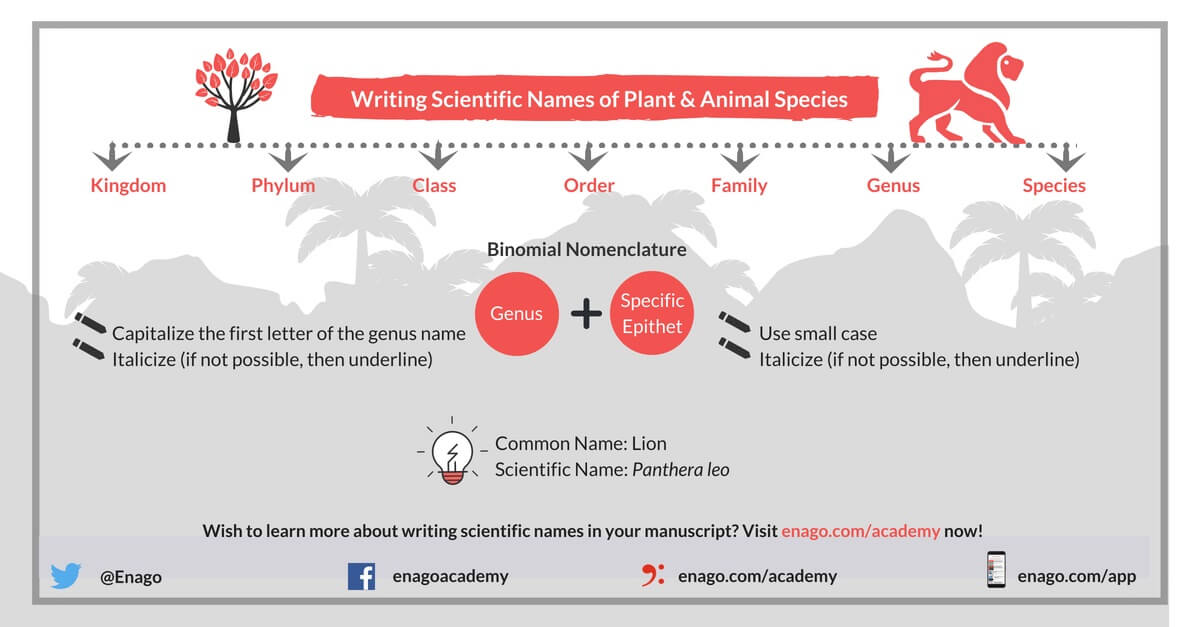How to Write Scientific Names of Plant and Animal Species in Journal Manuscripts (Part 1)

The format for writing scientific names of animals and plants is standardized and internationally accepted. “Scientific nomenclature” refers to various names according to a specific field of study. This article is the first in a series on scientific nomenclature within specific kingdoms.
Usually, animals & plants are identified by common and scientific names.
Common name: These are used locally and may vary by region or country.
Scientific name: These are unique names used by the scientific community to accurately and universally identify species.
International Codes of Nomenclature
Taxonomists have established several “codes” for scientific nomenclature. These codes are universal and are periodically updated by consensus. The protocol for naming species was invented in the 1700s by Swedish botanist Carl Linnaeus. Linnaeus created the system of “binomial nomenclature,” which uses only two designations–genus and specific epithet as the species name.
In the mid-1800s, scientists agreed on an expanded system of nomenclature. The following codes are used today:
- International Code of Nomenclature for algae, fungi, and plants.
- International Code of Zoological Nomenclature.
- International Code of Nomenclature of Bacteria recently changed to International Code of Nomenclature of Prokaryotes.
- International Code of Nomenclature for Cultivated Plants.
- International Code of Phytosociological Nomenclature.
- International Committee on Taxonomy of Viruses–publishes several reports including How to Write a Virus Name.
Common names of species can vary by geographic region but a universal protocol helps avoid ambiguity and ensures consistency.
Hierarchy
Known as the “taxonomic hierarchy,” the system consists of several groups of species based on genetic and phylogenic characteristics. The highest level is the “kingdom.” The first kingdom comprised only two types of living organisms—animals and plants. We have seven classifications within the kingdom domain—Bacteria, Archaea, Protozoa, Chromista, Plantae, Fungi, and Animalia.
Note that the designations are in Latin. This could be challenging for some who are not familiar with that language; however, the terms are globally consistent. There is no need to interpret them or translate them into another language.
The levels from highest to lowest classification are as follows:
- Domain
- Kingdom
- Phylum
- Class
- Order
- Suborder
- Family
- Genus
- Species
- Subspecies
Using this system, the gray wolf, for example, would be identified as follows:
- Domain: Eukarya.
- Kingdom: Animalia.
- Phylum: Chordata.
- Class: Mammalia.
- Order: Carnivora.
- Suborder: Caniformia.
- Family: Canidae.
- Genus: Canis.
- Species: lupus.
Binomial Name
The binomial name consists of a genus name and specific epithet. The scientific names of species are italicized. The genus name is always capitalized and is written first; the specific epithet follows the genus name and is not capitalized. There is no exception to this.
From above example, note that the classifications go from general (Animalia) to specific (C. lupus). A species, by definition, is the combination of both the genus and specific epithet, not just the epithet. For example, we can use the term gray wolf but we cannot use just Canis or lupus to describe this animal. Canis lupus is a species.
 Writing Scientific Names of Animals
Writing Scientific Names of Animals
When writing, we use both the scientific name and the “common” name on the first mention. We then choose which to use throughout and make it consistent.
- Gray wolf (Canis lupus) is native to North America and Eurasia.
In subsequent references, we can use either the common or scientific name. If we use the scientific name, we need only to use the first letter of the genus followed by a period and the specific epithet. For example:
- In North America, the gray wolf was nearly hunted to extinction.
- In North America, C. lupus was nearly hunted to extinction.
It is also common to refer to several species under one genus when you want to point out some similar characteristics within a genus. For example:
- All species of Canis are known to be moderate to large and have large skulls.
You could also write this same information another way as follows:
- Canis spp. are known to be moderate to large and have large skulls.
In this case, “spp.” is an abbreviation for “several species” (“sp” is the designation for one species) in the genus. Either of the above is acceptable. If you are focusing on a few species in particular, you would refer to the species name of each one.
You might also see a scientific name followed by an initial or abbreviation. This would denote the person who discovered or named the species. For example, in Amaranthus retroflexus L., the L (not italicized) refers to the original name given by Linnaeus.
Exceptions
There are a few exceptions to some of these rules. First, the entire genus name must be spelled out if it begins a sentence, even if a subsequent reference:
- Canis lupus was nearly hunted to extinction in North America.
Second, when more than one species has the same genus initial but come from different genera, the genera names are spelled out to avoid confusion:
- Both the gray wolf (Canis lupus) and the beaver (Castor canadensis) are native to North America.
In this case, it is best to use the common name after the first mention, but either format is correct.
Related: Do you have questions on manuscript drafting? Get personalized answers on the FREE Q&A Forum!
Titles and Headers
In titles, it is appropriate to write the entire scientific name of animals in uppercase letters. For example:
- A Study of the History of CANIS LUPUS in North America
In an italicized header, the species name can be written in non-italic style. For example:
- Canis lupus is nearly extinct in North America
Writing Scientific Names of Plants
Plant names also follow binomial nomenclature (similar to animal names).
- Royal grevillea (Grevillea victoriae) is found in New South Wales and Victoria.
In the plant kingdom, classification after species is subspecies (subsp.) and variety (var.). For example, there are three subspecies of Grevillea victoriae.
- Grevillea victoriae subsp. victoriae
- Grevillea victoriae subsp. nivalis
- Grevillea victoriae subsp. brindabella
When the species of a plant is unknown, a plant can be referred as Grevillea sp.
Moreover, when we collectively want to refer few or all species, we use Grevillea spp.
Similar to animal names, it is common to see a specific epithet that refers to a geographic area or the person who discovered it. For example, Grevillea victoriae F.Muell. Although these are proper nouns, they are still written in lowercase font. Be mindful that some word processors might attempt to capitalize these references.
This is something to check when proofreading your text.
Cultivar names are dictated by International Code of Nomenclature for Cultivated Plants
When writing, the cultivar name is added after genus or specific epithet and is put in single quotes without italicization. For example,
- Grevillea ‘Robyn Gordon’
- Grevillea rosmarinifolia ‘Rosy Posy’
Consistency
One of the basic rules of scientific writing is consistency. Regardless of your choice of scientific or common name, you must maintain consistency. Always check the author guidelines when preparing manuscripts. Formats for citations and references, headings, and section placement can be different. Be assured that the format for writing scientific names is internationally consistent regardless of the intended journal. The rules presented above will help.
In the next article in this series, we will discuss tips on how to write scientific names of bacterial species in a journal manuscript.
You see that the common name of the species you are studying has several variations depending on the geographic area. Which do you use and why? What other challenges do you face when using scientific nomenclature? Please share your thoughts with us in the comments section below.









Trying to identify species of plants is difficult when it changes from one reference to another. Is there a classification resource available to laymen with the most recently agreed upon name?
Hi Sandra,
Thank you for your question. Some databases give you updated information on plant taxonomy. Integrated Taxonomic Information System (ITIS) https://www.itis.gov/ is one such database. It gives you the flexibility to search taxonomic data of a particular plant based on its common name, scientific name, or taxonomic serial number. This database is not limited to plants and can be used to access taxonomic information about other organisms as well.
Meanwhile, please visit https://www.enago.com/academy/ and consider subscribing to our newsletter. Need instant answers for burning queries on academic writing and publishing? Install our mobile app today! https://www.enago.com/academy/mobile-app/
when we write only the genus name should it be italicized? for example we wan t to write leishmania parasites is that necessary to write the genus name italicized?,
Hi Mohammad,
The rules for the scientific nomenclature vary with the organism. In case of botanical nomenclature, generally both the genus and the species names have to be italicized. For protozoans, the genus name when used in singular form should always be in italics. e.g., Leishmania donovani. However, when used in the plural form, you need not italicize the genus name. e.g., Leishmania are responsible for causing the disease leishmaniasis.
Explained in a simple and easy to understand way. It was helpful.
when writing the manuscript, does the family name of the plant have be italicized?
Which one is inside the parenthesis in the title, common name or scientific name?
thanks